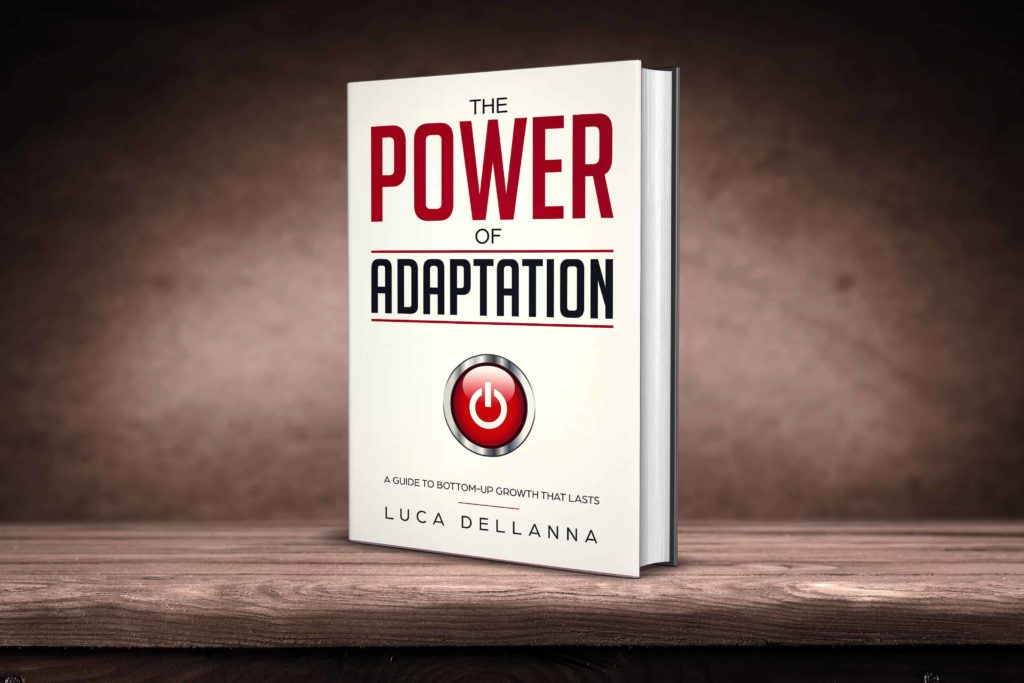There are two types of disciplined people: those who take consistent action through sheer willpower and those who do it without the use of willpower.
The essay below is an excerpt from my book “The Power of Adaptation: a Guide to Bottom-Up Growth that Lasts”. You can purchase it here.
Update: since I wrote this essay, I’ve been thinking a lot about antifragility and damage. I am currently writing a paper which provides a more detailed, clear and correct description of how things break and how they adapt. Below it, you will find the text of the old essay, for reference purposes.
Download link for the paper.
The Dynamics of Risk-Taking
Humans are antifragile (if you are not familiar with the concept, which has been originally proposed by Nassim Nicholas Taleb in his book Antifragile, please expand the following footnote). [footnote]Oversimplifying, humans and other living beings are antifragile: they benefit from stressors. Does it sound weird? Think about the last time you went to the gym: applying a physical stressor (the weights you lifted) made your muscles grow. Moreover, antifragile entities benefit from stressors in a nonlinear way. If you walk 2 kilometers per day, your athletic condition will not improve that much. However, if you run one kilometer per day at approximately twice your walking speed, your athletic condition will improve noticeably. The intensity of the stressor matters more than how many times it is applied. Other entities, such as ceramic vases, are fragile: they are harmed by stressors, in a nonlinear way. If you let a ceramic vase fall one hundred times from one inch, it will not break. However, if you let it fall once from one hundred inches, it will break. [/footnote] They benefit from stressors. By lifting weights, they become stronger. And yet, they can break, such as my ankle that time that I jumped from a wall a bit too high. Antifragile beings are antifragile only in a given range of stressors. Moreover, antifragile beings can became weaker, such as my grandma aging. Antifragile things can appear to become fragile. They never actually lose antifragility (the capacity to benefit from some stressors); rather, the range of stressors which are beneficial for them can shrink. Though antifragile entities never become fragile, they might change their likelihood to react to stressors like a fragile entity.
In this essay, I will explore the conditions upon which antifragile entities might change their response profile to stressors, a process which I call fragilization (or antifragilization, depending on the direction of the shift of the range of stressors which benefits them).
Antifragile entities can exhibit fragile behavior
Humans are antifragile. Jumping repeatedly over a moderate obstacle makes their leg muscles and joints stronger: an antifragile behavior. However, jumping from 5 meters tends to instead break their legs: a fragile behavior. It turns out that antifragile entities exhibit antifragile behavior only to a limited range of stressors. If the stressor is extremely high, even an antifragile entity will break. If a stressor is too low (such as lifting a matchbox), no benefit at all will take place. Therefore, antifragility is not unconditional. Antifragility is always related to a range, with a minimum threshold and a maximum one (with a simplification: see the footnote). [footnote] These thresholds are probabilistic. A given stressor has a certain percentage of inducing a response, and another percentage of inducing another response. For example, if I jump from the first floor, there is a probability of my ankle breaking. Such responses can usually be modeled with an S-function. As a simplification with the purpose of explaining in a more clear way the principle of fragilization, for the rest of the essay I will consider such S-functions step-functions instead. [/footnote].
The difference between antifragile and fragile entities is not that the former do not break under stressors; rather, antifragile entities become stronger if they receive stressors inside a given range, and that they become weaker if they lack such stressors; in other word, antifragile entities are adaptive and fragile ones are not. In the rest of this essay, I will describe how the adaptation process of antifragile entities to their environment works [footnote]or rather, how antifragile entities adapt to the stressors profile of their environment[/footnote].
Before continuing, let me clarify one key concept: antifragile entities cannot become fragile (i.e., they do not lose the property to positively react to stressors in a given range). Instead, they can have such range reduced. I call fragilization such reduction of the range of stressors that benefits them, and antifragilization its increase.
The conditions for antifragility
Antifragile entities have a common property: they comprise a population of sub-entities at a lower layer. Some examples:
- Animals and plants are composed by cells.
- Species are composed by a population of animals or plants.
However, also ceramic vases are composed by a population of ceramic molecules, and yet they are fragile. Something is missing in the previous definition. Let’s try again:
Antifragile entities have a common property: they comprise, at a lower level, a population of sub-entities which are subject to natural selection. Some examples:
- Animals and plants are composed by cells; if subject to a stressor, the weakest cells die.
- Species are composed by a population of animals or plants; if subject to a stressor, the weakest members die.
Natural selection is what provides antifragility. Natural selection necessitates stressors (to kill the weak).
Some might say: “hey, also the molecules of a ceramic vase undergo natural selection: if you make a vase fall, some of the molecules that form it (or rather, some of the bonds between them) will break; moreover, it’s not random ones that break: it’s the weakest ones.” Something is missing, again.
Antifragile entities only exhibit antifragile behavior when their underlying population dies in a distributed way. Some examples and counterexamples:
- Animals are composed by cells; if subject to a stressor, the weakest cells die. If the weakest cells die in a distributed, non-local way, the exhibited behavior is antifragile (lifting weights at the gym breaks only a few muscle cells here and there, and the muscles regrows them in excess, becoming stronger). If the weakest cells die in local way, the exhibited behavior is fragile (if I lift a very heavy high, my muscle might strain and I lose the ability to use it properly for a few days; if I jump from the third floor, all the cells in a given area of my leg bone break and the bone breaks).
- Species are composed by a population of animals or plants; if subject to a stressor (such as a famine), the weakest members die. If the members die in a distributed way (some members of this tribe, some children of this family), then the tribe or family grows stronger (thanks to natural selection and learning): an antifragile behavior. However, if all the members of a local population die, then, simply, that tribe is exterminated, without opportunity to adaptation (through natural selection and/or learning): a fragile behavior. [footnote]I just wrote that there are two processes for adaptation: natural selection and learning. However, are they really two separate processes? If one reframes learning as a natural selection between beliefs (either between opposing beliefs held or considered by the same person or between opposing beliefs held by different people; for example, the two beliefs that hunting in a given wood is safe), then no, they aren’t really two separate processes.[/footnote]
Obviously, another necessary property of antifragile entities is the ability of regrowing new members of the population it comprises (and of regrowing them in a quantity which is higher to the one needed to survive their current environment; in other words, the ability to create redundancy [footnote]this is needed because, otherwise, a stronger-than-usual stressor might kill the antifragile entity, preventing future adaptation (no one is left). This point will be explored further below[/footnote]).
The disappearance of antifragile responses
In the previous part, I described how an entity needs four conditions to be able to express an antifragile behavior:
- to be composed of a population at a lower layer,
- to allow for natural selection to act,
- to ensure that natural selection kills its lower layer in a distributed way,
- to be able to grow their lower-layer population up to a point of redundancy.
In the rest of this essay, I will describe what happens if natural selection is prevented (through the removal of skin in the game or through the introduction of “fences”) and what happens if conditions are present which might cause its population to die in a non-distributed way. In both cases, we will see, the consequence is fragility.
First, let’s see how a fragile entity reacts to stressors.

If the intensity of the stressor is lower than the fragility threshold, no change happens (if I let a ceramic vase fall from 1 inch, it doesn’t break).
If the intensity of the stressor is higher than the fragility threshold, the fragile entity breaks because its lower-layer population incurs a localized death (if I let a ceramic vase fall from 3 feet, the molecule bonds along a weak crystal boundary break and a crack appears).
(For the time being, I am applying a simplification: considering single stressors only. As engineers know, some entities exhibit a behavior called “fatigue failure”, where the effects of smaller stressors accrues over time. For the purpose of explaining the current concepts, I am only considering single stressors. Later in the essay, I will clarify the effects of distributions of stressors.)
Now, let’s see how an antifragile entity reacts to stressors.
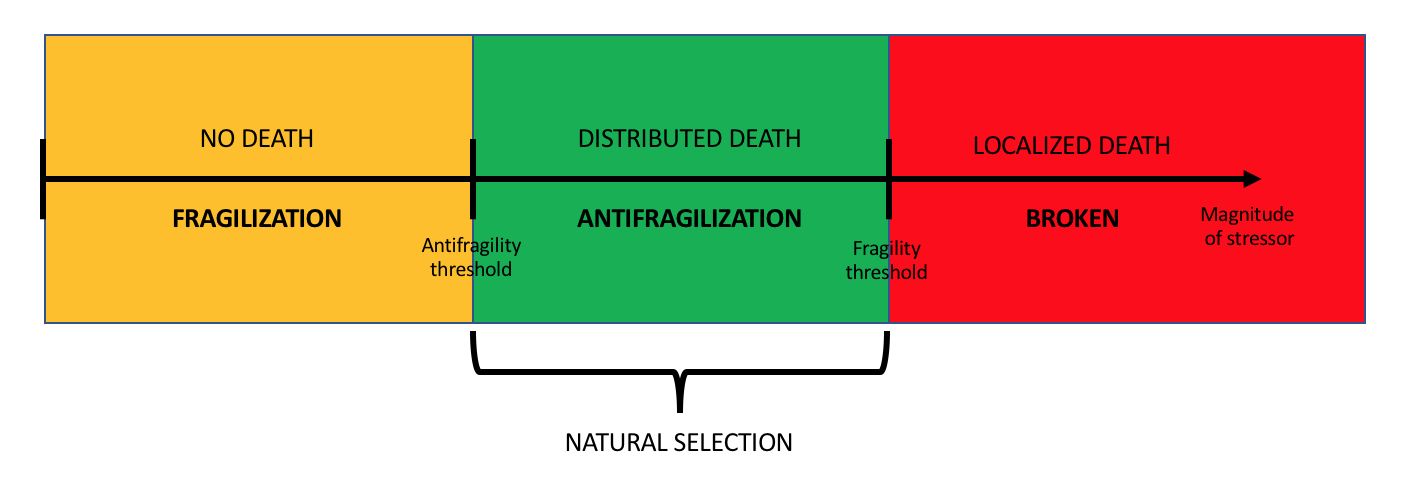
If the intensity of the stressor is higher than the fragility threshold, the antifragile entity breaks because some of its lower-layer population breaks in a localized pattern (for example, if I jump from the second floor, I might break a bone).
If the intensity of the stressor is between the fragility threshold and the antifragility threshold (the green area above), then antifragilization happens. For example, if I jump fifty times over a 3-feet tall obstacle, I will grow some leg muscles. Antifragilization happens because the lower-layer population dies in a distributed way (for example, I break some muscle fibers here and there: this triggers muscle regrowth. If I exercised too hard, I would broke the muscle fibers in a localized way and I would have a muscle strain: an injury, a fragile behavior). I call this behavior antifragilization because it modifies the future response of the antifragile entity to future stressors. Following the effect of the stressor in the antifragilization area, the fragility threshold moves to the right, as the entity grows stronger and able to withstand more intense stressors without breaking (the more I go to the gym, the more I can lift without straining myself). As a result, there is a bigger proportion of stressors which induce an antifragile response in my entity: it became more antifragile. Hence, antifragilization. I will describe this behavior better later on.
If the intensity of the stressor is, instead, lower than the antifragility threshold (the orange area in the image above), no member of the lower-layer population dies. For example, if I lift a matchbox, the weight is too low to break any of my muscle fibers and to induce any muscle growth. If, over time, no stressor happens to be higher than the antifragility threshold, then fragilization happens. If I do not exercise for a few of months, my muscles mass will decrease, and I will lose the ability to lift heavy weights. In such case, both the antifragility threshold and the fragility one decrease (moving to the left in the image above). Because the fragility threshold lowered, the antifragile entity is more likely to express a fragile behavior (because, given a stable distribution of stressors, now a bigger proportion of them falls above such threshold). Therefore, fragilization, I will describe this behavior over the next paragraphs, just after antifragilization.
Antifragilization
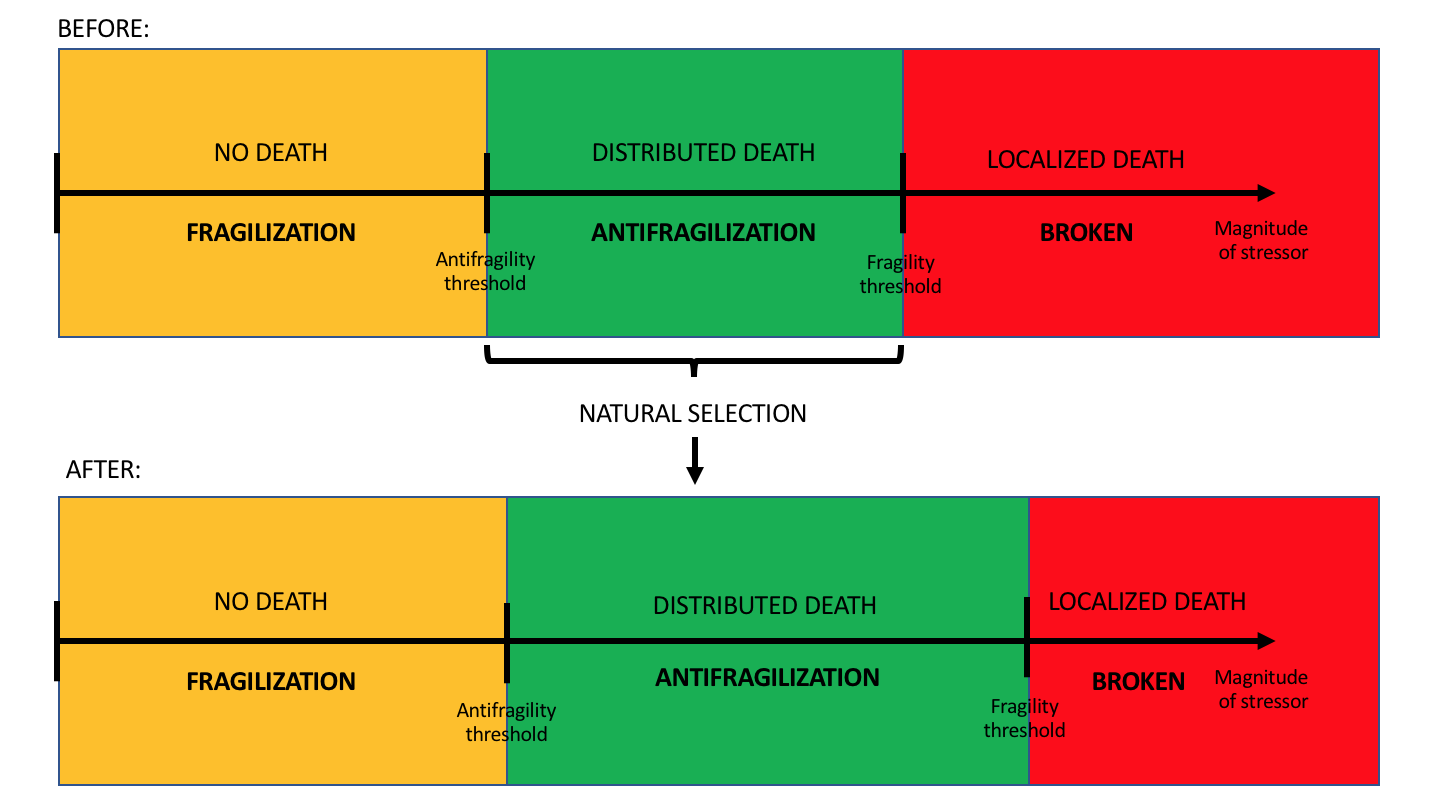
As displayed in the image above, antifragilization (the process that happens when an antifragile entity is exposed to stressors whose intensity falls between the fragility and antifragility thresholds), consists in a distributed death, followed by an adaptation and therefore an increase in both the antifragility and the fragility threshold. The increase in the fragility threshold is bigger than the increase in the antifragility threshold, so that the range of stressors inducing an antifragile reaction is bigger, and therefore the antifragile entity becomes more likely to exhibit an antifragile reaction.
Why does antifragilization happen?
Antifragilization is the result of adaptation following natural selection.
Step by step:
- A stressor hits the antifragile entity. For example, I lift some weights.
- The stressor is strong enough to induce natural selection: it kills the weakest members of the lower-level population. Continuing the example, lifting the weights causes some of my muscle fibers to break.
- In antifragile entities, those weakest members are usually normally distributed; therefore, a distributed death occurs. The distributed death is well-absorbed by the entity and therefore does not cause it to permanently lose any functionality. (I will describe later what happens if, due to some external intervention, the weakest members are not distributed and therefore a localized death takes place.) Continuing the example, the muscle fibers which break are not grouped in a single location (as it would happen in case of a strain) but are distributed along all the muscle.
- A first effect, is that since the weakest members of the population died, the average survivor is stronger. Only the strongest will reproduce, generating a second-generation population which is stronger than the first one on average. Continuing the example, it is the weaker muscle fibers that die; only the strongest fibers will be left to reproduce, so that the muscle fibers that are born will be strong, on average.
A variation of this effect, applicable to populations of humans, is that of learning. Following the negative event, the members of the population that were practicing the weakest beliefs die, leaving only the members with the strongest beliefs alive and able to reproduce. If a source of water in the village is contaminated, only those members of the population who thought that boiling/alcohol are not necessary to purify the water will die, leaving those who thought that boiling/alcohol are necessary alive and able to pass their advantageous beliefs to the new generation of the population. - As a second effect, the intense stressor creates an expectation of more intense stressors to come, so that the need for redundancy is established, and overgrowth is triggered. Continuing the example, lifting weights creates the expectation, in my body, that it will have to lift more weights in the future; it better prepare itself for the task by growing muscles which are not only strong enough to lift the weight I just lifter, but even stronger to lift even heavier weights. This is the process behind muscle mass growth at the gym. [In what resembles a bayesian interpretation of the world, after being exposed to an intense stressor, our body intuitively modifies the distribution of future expected stressors, so that even stronger stressors, never experienced before, are deemed possible.]
- The consequence of the two effects described before is an increased tolerance to stressors, which causes both the antifragility and the fragility thresholds to increase.
Fragilization
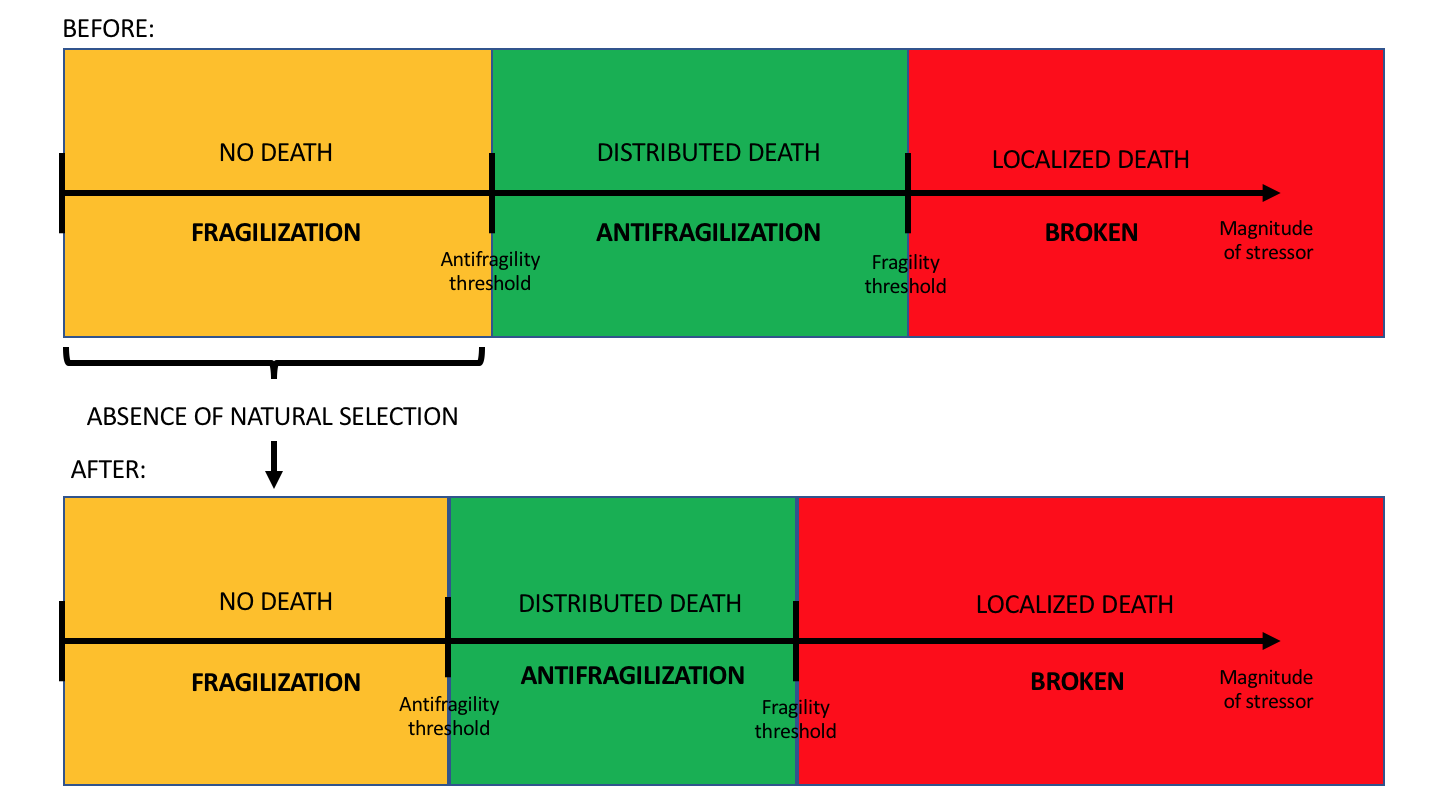
Fragilization is the result of the lack of stressors and, thus, of natural selection (which needs stressors to kill the weak).
Step by step:
- For a certain time (weeks, usually), an antifragile entity lacks exposure to stressors above the antifragility threshold. For example, for three months I do not make any physical exercise.
- In that period of time, natural selection does not take place in the population at the lower layer (at least along the dimension of the lacking stressors). Continuing the example, in those three months no muscle fiber breaks because of an applied physical stressor.
- A first effect takes place: because of the lack of natural selection, the weakest members of the lower-layer population do not die and are therefore allowed to reproduce. The second generation population has thus a lot of weak members, which means that both the antifragility threshold and the fragility ones become lower. Continuing the example, the weaker muscle cells are allowed to reproduce, and therefore the muscles contain an increasing proportion of weak cells.
- A second effect takes place: because of the lack of stressors, there is no (apparent) need for redundancy anymore. Redundancy is useful only in bad times; in good ones, it seems unnecessary. Therefore, the antifragile entity adapts in such a way to reduce redundancy. This makes sense, because optimization is an adaptation to stability (for it assumes certain conditions, to which the entity optimizes for, to be present also in the future), whereas redundancy is an adaptation to volatility (for, if no condition is assumed stable, there is no stable condition to optimize for). The lack of redundancy makes the antifragile entity more vulnerable to failure, and therefore more fragile (the fragility threshold becomes lower). Continuing the example, because I didn’t lifted any weight for months, my body assumes I will not have to lift any weight in the future either. It then appears advantageous to reduce the number of muscle cells (to save energy, between other reasons). This makes me more likely to strain my muscles in case in the future I will suddenly have to lift an heavy weight.
- The consequence of the two effects described before is a decreased tolerance to stressors, which causes both the antifragility and the fragility thresholds to increase.
Antifragile entities are adaptive
As described with the two processes of fragilization and antifragilization, the range of stressors which induce an antifragile reaction in an antifragile entity is not fixed. Antifragile entities are adaptive: this confers them an advantage in a changing environment. However, precisely because they are adaptive, they can also adapt to a stable environment. Adapting to an unstable environment makes an entity “more antifragile” (i.e., more likely to exhibit an antifragile reaction and to adapt to its environment), and adapting to a stable environment makes an entity “less antifragile” (i.e., less likely to exhibit a fragile reaction and to instead not adapt to its environment). Again, I must clarify: antifragile entities never lose their capacity to being adaptive (i.e., to benefit from stressors in a given range); however, they might shrink the range of stressors towards which they react in an adaptive way. Therefore, though antifragile entities never become fragile, they might change their likelihood to react to stressors like a fragile entity.
The importance of natural selection
As described above, lack of natural selection causes fragilization.
There are mainly two processes which prevent natural selection: the removal of skin in the game and the introduction of exogenous barriers (aka “fences”). The next part of this essay will describe them.
(Side note: hacks and quick fixes, which which offer apparently safer shortcuts but tend to bypass or alter natural selection, bring fragility.)
Introduction of skin in the game
First, let’s see what happens if skin in the game is increased in the population forming the lower layer of the antifragile entity. For example, if a human nation (an antifragile entity) passes a law to enforce skin in the game for its citizens (the population at the lower layer).
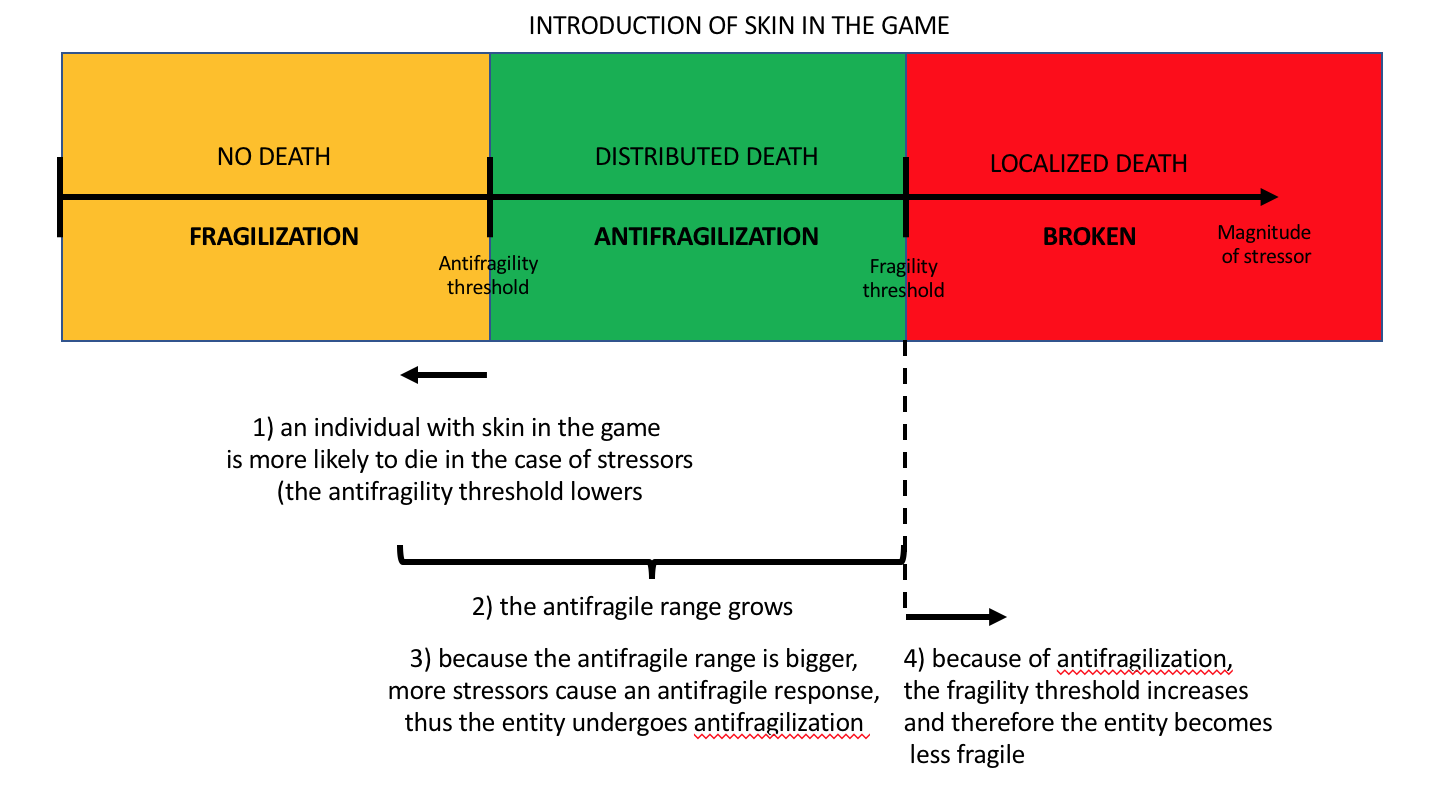
- First, the introduction of skin in the game introduces direct accountability: one is more likely to suffer for his mistakes. Since mistakes usually become evident not when things go well, but the moment they turn awry, it is usually following the application of an external stressor (such as a financial crisis) that an individual with skin in the game exits the population (for example, it goes broke or gets fired from his investment firm). The more skin in the game, the more, as a first-order effect, weak individuals are likely to fail in case of stressors; such failure is likely to be distributed (thanks to skin in the game, only the weak individuals fail, without bringing anyone down with them), therefore, it is the antifragility threshold which gets lowered.
- Because the antifragility threshold became lower, the antifragililization range (the green area) become bigger.
- A random stressor is now more likely to induce antifragilization (a stressor which would have hit the right side of the orange area would now hit the left side of the green area). Therefore, antifragilization is more likely to happen.
- As a result of antifragilization, the fragility threshold increases. As a consequence, a random stressor is now more likely to hit the antifragilization area (a stressor which would have hit the red area in its left side would now hit the green area in its right side), and the entity is now more likely to exhibit an antifragility response.
- Because of the antifragile response being solicited more often, antifragilization happens more often, and the fragility threshold now increases moving to the right and offsetting the movement it did to the left during the first step.
As a result, thanks to skin in the game, all members of the population are now safer (less likely to die because of a random stressor).
It is worth noting that the dominant effect, and the only one significant over the long term, is the one described in the fifth point above, a second-order effect. However, because policy makers usually only think terms of first-order effect, they might take wrong decisions, some that only appear to work in the short term.
Now, let’s see what happens in the opposite case, the removal of skin in the game.
Introduction of exogenous barriers (aka, “fences”) and the removal of skin in the game
Humans do not like risky environments, and often introduce barriers to make them safer. However, often such barriers only increase the sense of safety. As Pasquale Cirillo describes in “The Fence Paradox”, because the barriers reduce the smaller stressors, humans feel safe, they take more risks, increasing the risk of an important negative event once a stronger stressor appears.
In The Fence Paradox, Dr. Cirillo tells a story of tourists taking pictures from the edge of a canyon. Since it is a risky endeavor, only a few tourists venture to the edge, and only do so with great care. One day, one of them goes a bit too far on the edge and falls down, dying. In response to this unlucky event, a fence is build on the edge of the canyon. It now looks safe to take pics from the edge, and tourists flock in. They lean on the fence to take pictures, and push each other in an attempt to take better shots. One day, a big group of tourists relays too much on the fence and they apply too much of their weight to it: the fence collapses, causing the whole group leaning on it to fall and die. After all, the fence didn’t make the canyon safer; it only made it safer to the population exposed to (or exposing itself to) smaller stressors, whereas it made it less safe in case of exposure to bigger stressors (or making the population more likely to expose themselves to bigger stressors).
The image below describes the fragilization which follows the introduction of exogenous barriers [footnote] I call them exogenous to differentiate them from barriers inherent to the population itself, such as a turtle’s shell, which do not necessarily cause fragilization.[/footnote] (which, by causing the population to reduce their exposure to the consequence of some of their actions, is not so different from the removal of skin in the game).
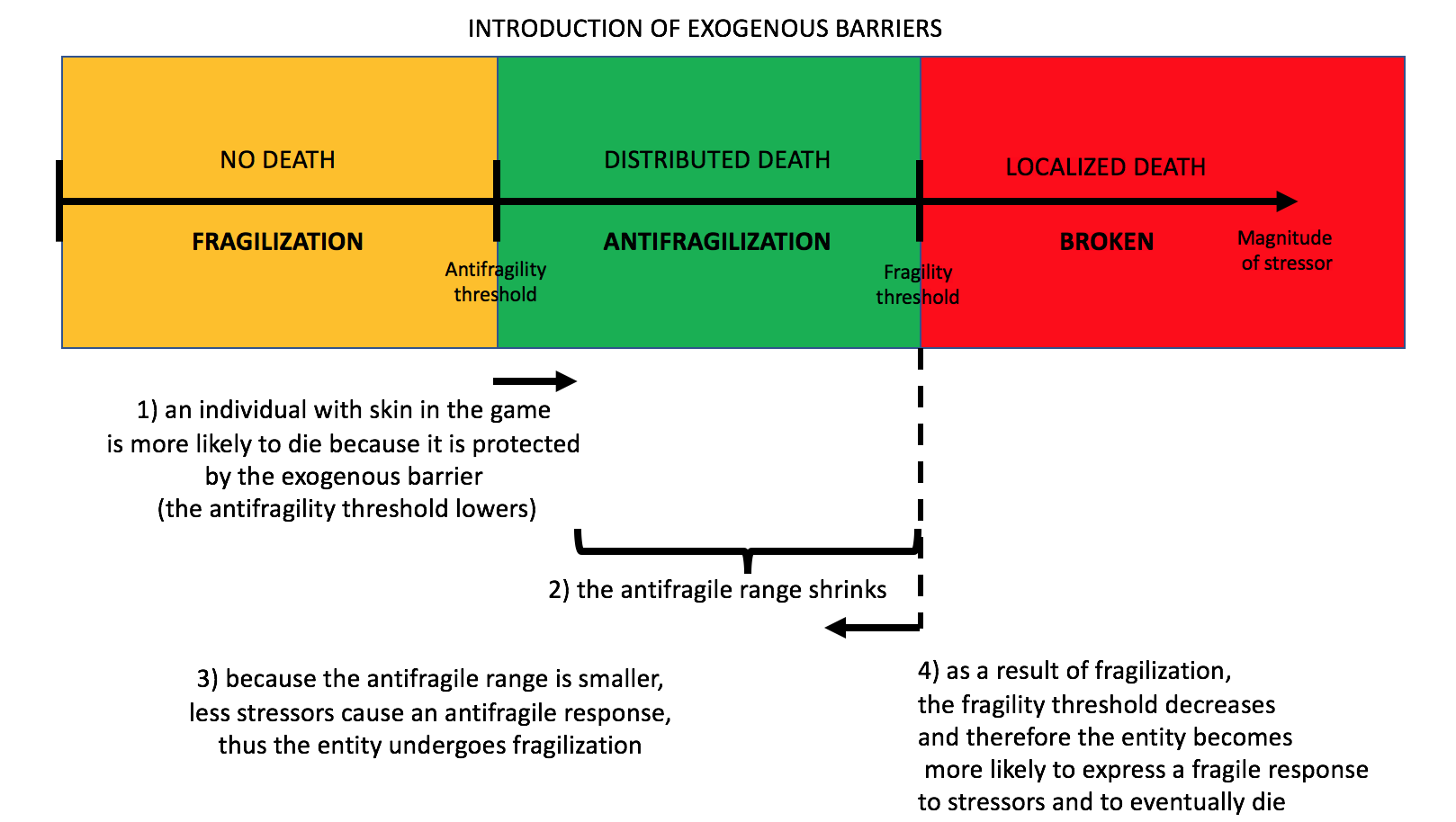
- First, the introduction of exogenous barriers reduces direct accountability: one is less likely to suffer for his mistakes. As a first order effect, weak individuals are less likely to fail in case of (small) stressors; therefore, the fragility threshold increases.
- Because the antifragility threshold became higher, the antifragililization range (the green area) becomes smaller.
- A random stressor is now less likely to induce antifragilization (a stressor which would have hit the left side of the green area would now hit the right side of the orange area). Therefore, antifragilization is less likely to happen and fragilization is now more likely to take place.
- As a result of fragilization, the fragility threshold decreases. As a consequence, a random stressor is now more likely to cause death (a stressor which would have hit the green area in its right side would now hit the red area in its left side), and the entity is now more likely to exhibit a fragile response.
As a result, thanks to the introduction of exogenous barriers, all members of the population are now less safe (more likely to die in a localized way in case of exposure to a strong stressor).
The importance of redundancy
In a first-order analysis, redundancy might seem to reduce the likelihood of antifragilization, for there is a higher probability that an exterior stressor is not perceived interiorly. For example, if I am strong (i.e., I have redundant muscles for most daily activities), I will not grow muscles by lifting my not-too-heavy grocery bags, whereas if I am weak and start lifting heavy grocery bags every day, I might actually grow some muscles.
However, a second-order analysis shows the opposite consequence: redundancy increases one’s willingness to expose himself to stressors, and/or his opportunities to do so. A strong person is more likely to go to the gym [footnote] and a person going to the gym is more likely to be strong; the two affirmations are not at odds[/footnote], whereas a weak person is less likely to expose itself to stressors (for example, to offer to help to move furnitures).
Moreover, a stronger person (i.e., a person with redundant muscles) is more likely to survive a stronger-than-usual stressor, meaning that it is more likely to survive to benefit from the stressors. A weak person (one with no redundancy) is more likely to injure itself or to die in case of extreme physical stress, and therefore less likely to continue its exposure to the smaller, more beneficial stressors that will take place in the future.
Therefore, a certain degree of redundancy is beneficial to antifragility.
How to become antifragile?
To conclude, there are four necessary conditions for antifragility, and four actions which can increase it.
The 4 necessary conditions for an entity to be antifragile:
- It has be composed of a population at a lower layer, and
- Natural selection has to be allowed at that lower layer, and
- Killings from natural selection have to happen in a distributed fashion, and
- The surviving members of the population have to be able to reproduce.
The 4 actions which can increase the likelihood of an antifragile response to a random stressor:
- Ensuring skin in the game.
- Removing exogenous barriers (aka, fences).
- Encouraging redundancy.
- Reducing sistemicity.
It is worth noting that the 4 action points above only work as second-order effects, and that understanding them requires a dynamic representation of the world. People using static representations of the world (IYIs), and therefore unable to understand second-order effects, are likely to dismiss them as useless.
(This essay is an excerpt from my book “The Power of Adaptation: a Guide to Bottom-Up Growth that Lasts”)
Appendix: Scalability
Groups of humans seem to have a problem with scalability: as they grow bigger, they tend to grow more fragile as well. This is not a surprise. The common ways that humans deal with scale, at least in modern times, seem to be bureaucracy (removal of skin in the game), regulations (exogenous barriers), optimization (reduction of redundancy) and centralization (an increased risk of sistemicity), all of which increase fragility.
******
If you enjoyed this essay, you might consider subscribing to my future ones.

